It looks like you're using an Ad Blocker.
Please white-list or disable AboveTopSecret.com in your ad-blocking tool.
Thank you.
Some features of ATS will be disabled while you continue to use an ad-blocker.
share:
While once again reviewing the well-known sarcophagus lid of Mayan ruler "Pakal" (more
details here) I noticed something that I never paid much attention to before. Now, I'm of course well aware of the fact that comparisons between
this particular lid and spaceships/rockets have always been drawn ever since von Däniken and other AA proponents made their case for the ancient
astronaut theory.
BUT - and that's IMO the new thing here - I tend to believe the lid is probably NOT so much a representation of "actual hardware", but rather an artistic copy of a technical drawing or blueprint. But lets have a look at the lid first:
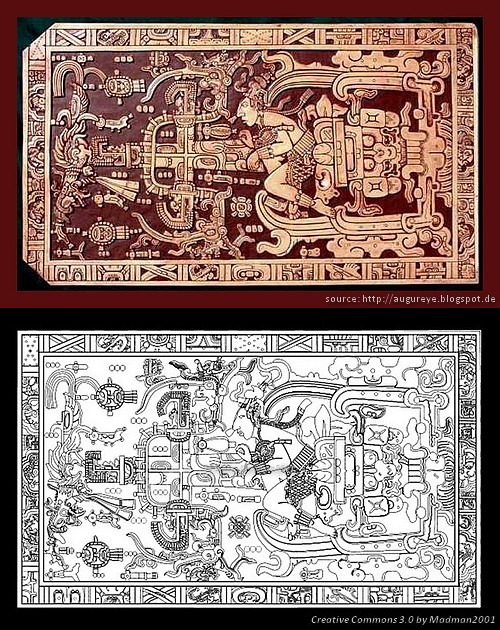
And now let's compare that to some of NASA's blueprints & conceptual drawings of the Mercury capsule:
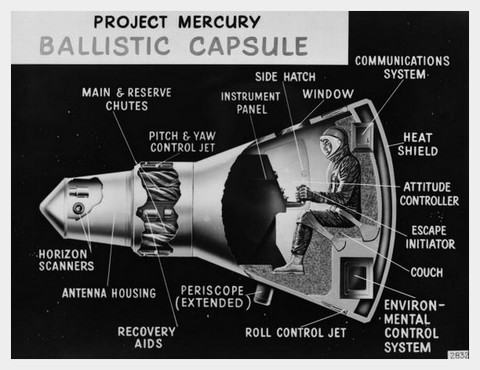
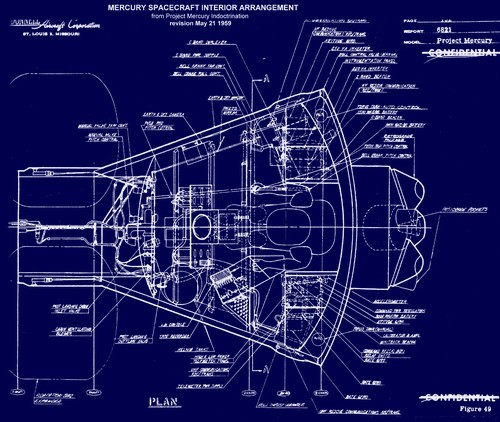
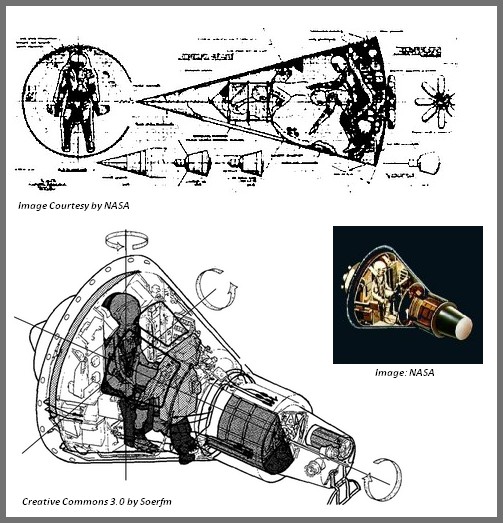
IMO there's a stunning correlation between the various blueprints & what we see on the sarcophagus lid. It's especially interesting how Pakal's body is embedded inside his "machine", closely resembling the position and bearing of Mercury astronauts on the technical drawings.
Now, if the depiction on the sarcophagus lid was indeed based on blueprints, then we'd also need to ask a variety of further questions, such as:

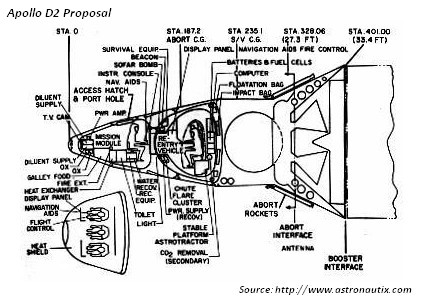
Needless to say that I'm just freestylin' here, but the "ancient blueprint theory" would also tie in with the depictions of the Dendera lights (reminiscent of a crooke's tube) and the Dendera zodiac (possibly showing the cross-section of a 4-pole DC Generator with eight coils surrounding an armature core).
In all cases, the detail level mostly consists of cultural and artistic elements of the time, but the general & overall concept is highly reminiscent of a functional & well-known design of our days.
Whatever the case, the Mayans were most probably "in the know" about advanced technology (with or without really understanding it). And as far as Pakal's ultimate & final trip is concerned: wouldn't it be understandable if the Mayans wanted their ruler to leave the realms of the living by ascending to heaven in the very same way as their "Gods" once did ... ? I think that would be more than reasonable!
Just some food for thought ... looking forward to your comments!
P.S.: Details on the traditional interpretation of the artwork on the sarcophagus lid can be found here
BUT - and that's IMO the new thing here - I tend to believe the lid is probably NOT so much a representation of "actual hardware", but rather an artistic copy of a technical drawing or blueprint. But lets have a look at the lid first:

And now let's compare that to some of NASA's blueprints & conceptual drawings of the Mercury capsule:



IMO there's a stunning correlation between the various blueprints & what we see on the sarcophagus lid. It's especially interesting how Pakal's body is embedded inside his "machine", closely resembling the position and bearing of Mercury astronauts on the technical drawings.
Now, if the depiction on the sarcophagus lid was indeed based on blueprints, then we'd also need to ask a variety of further questions, such as:
- Why would the Mayans be inspired by blueprints?
- How did they get access to them? Did they find the remains of a previous, much more advanced civilization?
- Did they have contact with "visitors" who showed & explained their technological culture to them using technical drawings?
- Did these visitors take the blueprints with them again so that the subsequent artistic depictions were just approximations of what they
(the Mayans) could recall from their memory (a blend between the "real thing" and the "inner workings")?
- Wouldn't one otherwise expect the depiction on the lid to be more of a 1:1 copy if they actually had the drawings at their disposal?
(...)


Needless to say that I'm just freestylin' here, but the "ancient blueprint theory" would also tie in with the depictions of the Dendera lights (reminiscent of a crooke's tube) and the Dendera zodiac (possibly showing the cross-section of a 4-pole DC Generator with eight coils surrounding an armature core).
In all cases, the detail level mostly consists of cultural and artistic elements of the time, but the general & overall concept is highly reminiscent of a functional & well-known design of our days.
Whatever the case, the Mayans were most probably "in the know" about advanced technology (with or without really understanding it). And as far as Pakal's ultimate & final trip is concerned: wouldn't it be understandable if the Mayans wanted their ruler to leave the realms of the living by ascending to heaven in the very same way as their "Gods" once did ... ? I think that would be more than reasonable!
Just some food for thought ... looking forward to your comments!
P.S.: Details on the traditional interpretation of the artwork on the sarcophagus lid can be found here
edit on 9-5-2014 by jeep3r
because: text
a reply to: butcherguy
No worries, not at all offended!
It's not a 100% identical match, but a very very close one in terms of the general style in which we ourselves draft "blueprints" of technical devices. IMO that's the most evident aspect of this comparison. But I'm of course also looking forward to what others have to say ...
No worries, not at all offended!
It's not a 100% identical match, but a very very close one in terms of the general style in which we ourselves draft "blueprints" of technical devices. IMO that's the most evident aspect of this comparison. But I'm of course also looking forward to what others have to say ...
edit on 9-5-2014 by jeep3r because: text
a reply to: jeep3r
You've got the sarcophagus lid tilted the wrong way. It is not meant to be viewed horizontally like that, but vertically, because the King depicted atop the altar has the Tree of Life erupting from his body and reaching toward the Heavens.
As for the Maya and other Mesoamerican tribes being "in the know", if this was the case, how come the Spanish were able to so easily defeat them?
You would think that cultures in possession of blue-prints for rockets and other mechanical machines would have easily overcome the Spanish.
The fact that history played out otherwise, begs the question: were the Maya, Aztecs, and others actually "in the know" at all?
~ Wandering Scribe
You've got the sarcophagus lid tilted the wrong way. It is not meant to be viewed horizontally like that, but vertically, because the King depicted atop the altar has the Tree of Life erupting from his body and reaching toward the Heavens.
As for the Maya and other Mesoamerican tribes being "in the know", if this was the case, how come the Spanish were able to so easily defeat them?
You would think that cultures in possession of blue-prints for rockets and other mechanical machines would have easily overcome the Spanish.
The fact that history played out otherwise, begs the question: were the Maya, Aztecs, and others actually "in the know" at all?
~ Wandering Scribe
a reply to: MonkeyFishFrog
IMO it could well be both: I don't see immediate contradictions for this being a cultural and symbolic representation (world tree) inspired by something very mighty and impressive which ancient cultures may have encountered at some point in the past.
In that case, they'd certainly interpret any potential technology they might have come across using their own symbols and artistic elements. The same could be the case for the Dendera lights ... at least IMO.
IMO it could well be both: I don't see immediate contradictions for this being a cultural and symbolic representation (world tree) inspired by something very mighty and impressive which ancient cultures may have encountered at some point in the past.
In that case, they'd certainly interpret any potential technology they might have come across using their own symbols and artistic elements. The same could be the case for the Dendera lights ... at least IMO.
edit on 9-5-2014 by jeep3r because: text
Definitely some sort of machine. Whether it is a tunnel making machine or a flying machine is the question. It could also be something for viewing
the stars. Definitely evidence of some metalworking there. Who did it belong to is a question.
a reply to: jeep3r
Opinions in this case does not matter. The Mayans were deliberate in their logographs and their positioning.
Pakal is lying on an altar with the world tree growing through him. This is symbolic for his position of power (being a ruler) and also for his part in the circle of life because the tree grows through him only through his death.
Trees don't grow sideways so, yes, orientation here is of utmost importance.
Opinions in this case does not matter. The Mayans were deliberate in their logographs and their positioning.
Pakal is lying on an altar with the world tree growing through him. This is symbolic for his position of power (being a ruler) and also for his part in the circle of life because the tree grows through him only through his death.
Trees don't grow sideways so, yes, orientation here is of utmost importance.
I wonder if it could have been a telescope? His hands are definitely engaged in activities that suggest dial adjustments to me. Now whether it was a
vehicle or not is another question. It does not look like any interpretation of a tree of life to me, fwiw.
originally posted by: Wandering Scribe
a reply to: jeep3r
As for the Maya and other Mesoamerican tribes being "in the know", if this was the case, how come the Spanish were able to so easily defeat them?
Well, that's what I was theorizing: could they have inherited some kind of technological influence at some point in the past WITHOUT having permanent access to that technology (but knowing that it was something very special, something to actually worship).
Of course they couldn't relate to the true workings of a complex machine based on electricity, chemical reactions or electro-magnetism. But they could perhaps have used their own cultural terms and symbols to "preserve" that long forgotten knowledge (eg. if they were 'in contact' with an advanced civilization at some point in the past).
The problem is that an alien civilization that could come here would have a more modern capsule. Mercury is primative to us and they would have to be
way more advanced then we are now.
Sure looks like he is trying to drive or control something with his hands and feet.
I can see where your coming from.
I can see where your coming from.
East Indian lore also tells of sky ships provided to royalty by other worldly beings...also describes a trip outside the atmosphere that's pretty
convincing technically.....whos to say that it wasn't easier for contact with us when we had no technology back then....now of course wed just try to
obtain the stuff for weapons...
edit on 9-5-2014 by stirling because: (no reason given)
a reply to: ArtemisE
It's not a 1:1 comparison (perhaps I should have made that more clear in my OP), it's more about the way in which the lid seems to depict a technical device just in the same way we would depict it using blueprints.
The Mercury capsule just happens to be a pretty good match, whereas Pakal's machine may well be different because the detail level uses conventional mayan artwork elements.
So, any potential technological civilization that might have been in contact with the ancients, would certainly have drafted "blueprints". Perhaps some of these were seen by the ancients at some point in the past. When said technology was no longer around, only memories were left and the ancients inherited this knowledge using their own cultural terms & symbols.
It's not a 1:1 comparison (perhaps I should have made that more clear in my OP), it's more about the way in which the lid seems to depict a technical device just in the same way we would depict it using blueprints.
The Mercury capsule just happens to be a pretty good match, whereas Pakal's machine may well be different because the detail level uses conventional mayan artwork elements.
So, any potential technological civilization that might have been in contact with the ancients, would certainly have drafted "blueprints". Perhaps some of these were seen by the ancients at some point in the past. When said technology was no longer around, only memories were left and the ancients inherited this knowledge using their own cultural terms & symbols.
a reply to: bhornbuckle75
An interesting debunking attempt, indeed. But as mentioned in the OP: the detail level actually "consists" of traditional mayan symbolism and artwork, that's quite clear and without doubt. Yet the overall arrangement of these elements has a striking resemblance to some kind of technological device.
Again, I don't see a contradiction between an early technological influence of some sort and a subsequent mayan symbolism and artwork having been inspired by that bygone era. The question is perhaps: has this particular culture (and other ancient societies as well) possibly inherited an early technological influence into their symbolism, without the ability to really relate to that technology once this influence was gone?
An interesting debunking attempt, indeed. But as mentioned in the OP: the detail level actually "consists" of traditional mayan symbolism and artwork, that's quite clear and without doubt. Yet the overall arrangement of these elements has a striking resemblance to some kind of technological device.
Again, I don't see a contradiction between an early technological influence of some sort and a subsequent mayan symbolism and artwork having been inspired by that bygone era. The question is perhaps: has this particular culture (and other ancient societies as well) possibly inherited an early technological influence into their symbolism, without the ability to really relate to that technology once this influence was gone?
a reply to: jeep3r
In the instance of what you're referring to, we must use Occam's Razor. What is the more likely explanation:
1) Pacal's sarcophagus incorporates common Mayan symbolism and glyphs, arranged in a spiritual/religious manner common to Mayan art and architecture, because the lid is meant to represent a spiritual/religious concept: the soul's journey upon the Tree of Life after its bodily death.
or...
2) Pacal's sarcophagus incorporates common Mayan symbolism and glyphs, arranged in a spiritual/religious manner common to Mayan art and architecture, because the lid is meant to represent a mechanical device found nowhere else in their art, architecture, or history; and they had no other reference points for use when attempting to recreate something they saw right in front of them.
It requires a greater suspension of disbelief to think that the Mayan culture, which included worship of Itzamna, the flying bird-god, needed to utilize a terrestrial motif, the Tree of Life, to abstractly represent a flying machine.
~ Wandering Scribe
In the instance of what you're referring to, we must use Occam's Razor. What is the more likely explanation:
1) Pacal's sarcophagus incorporates common Mayan symbolism and glyphs, arranged in a spiritual/religious manner common to Mayan art and architecture, because the lid is meant to represent a spiritual/religious concept: the soul's journey upon the Tree of Life after its bodily death.
or...
2) Pacal's sarcophagus incorporates common Mayan symbolism and glyphs, arranged in a spiritual/religious manner common to Mayan art and architecture, because the lid is meant to represent a mechanical device found nowhere else in their art, architecture, or history; and they had no other reference points for use when attempting to recreate something they saw right in front of them.
It requires a greater suspension of disbelief to think that the Mayan culture, which included worship of Itzamna, the flying bird-god, needed to utilize a terrestrial motif, the Tree of Life, to abstractly represent a flying machine.
~ Wandering Scribe
a reply to: Wandering Scribe
Well versed and logical, on the one hand. On the other, I'd like to emphasize that I'm collecting "schemes" or patterns (if you will) across different cultures linked to unusual depictions, such as this one (or the Dendera lights) which may point to something we misinterpreted.
By that, I mean that a piece of artwork uses cultural elements of the time on the 'detail level', yet the general appearance (or the overall concept) is very specific and meaningful to us in our technological world. Coincidence? I'm not so sure when I compare eg. the Dendera lights with a Crooke's tube or this particular lid design with a technological device (see OP) ... Occam's razor is a good choice, but perhaps we shouldn't apply it all too soon for we never know what transcultural links we may find in future.
Well versed and logical, on the one hand. On the other, I'd like to emphasize that I'm collecting "schemes" or patterns (if you will) across different cultures linked to unusual depictions, such as this one (or the Dendera lights) which may point to something we misinterpreted.
By that, I mean that a piece of artwork uses cultural elements of the time on the 'detail level', yet the general appearance (or the overall concept) is very specific and meaningful to us in our technological world. Coincidence? I'm not so sure when I compare eg. the Dendera lights with a Crooke's tube or this particular lid design with a technological device (see OP) ... Occam's razor is a good choice, but perhaps we shouldn't apply it all too soon for we never know what transcultural links we may find in future.
edit on 9-5-2014 by jeep3r because: text
a reply to: jeep3r
We can apply Occam's Razor to the Dendera relief as well though. For example:
1. The Dendera relief features (left-to-right, among others) the deities Geb (standing), Isis (sitting), Osiris (in his Djed-pillar form), and Atum-Re (upon the pillar). The relief also features a Lotus, the symbolic representation of the origin of the Universe according to both the Ogdoad and Ennead, Egypt's two most prominent cosmological theories; the uplifted hands, symbolic of Heka, the Egyptian concept of divinity and magic; and a serpent, possibly a depiction of Wadjet, the royal-cobra whose function was to protect the Pharaoh, and who was later synchronized with the goddess Hathor. All of this is contained within the Temple of Hathor, in Dendera, a place of religious and spiritual importance. Therefore, it is highly likely that the relief is a representation of Egyptian creation-mythology, with the Lotus out of which Atum-Re rose, and the bubble of air, known as Shu, who fathered the first-Pharoah, Geb, who fathered four children: Set, Osiris, Isis, and Nephthys all of whom were important spiritual and religious figures to both the common Egyptian and the royal Egyptians.
or...
2. If you squint, the Lotus in the Nun kind of looks like a filament. If you squint, the presence of Wadjet within Shu kind of looks like the coil in a bulb. If you squint, the Djed-pillar and Heka kind of look like a stand. Therefore it must be an ancient depiction of a light bulb! Just, uh, ignore the presence of Geb, Isis, and Atum-Re.
Again, which is more likely? The Egyptians were visually representing their religious beliefs, or they were trying to represent an invention that they themselves created, but lacked the proper motifs, and so they blasphemed their gods and sacred myths to do it... one time... on one temple wall... in all of their history.
~ Wandering Scribe
We can apply Occam's Razor to the Dendera relief as well though. For example:
1. The Dendera relief features (left-to-right, among others) the deities Geb (standing), Isis (sitting), Osiris (in his Djed-pillar form), and Atum-Re (upon the pillar). The relief also features a Lotus, the symbolic representation of the origin of the Universe according to both the Ogdoad and Ennead, Egypt's two most prominent cosmological theories; the uplifted hands, symbolic of Heka, the Egyptian concept of divinity and magic; and a serpent, possibly a depiction of Wadjet, the royal-cobra whose function was to protect the Pharaoh, and who was later synchronized with the goddess Hathor. All of this is contained within the Temple of Hathor, in Dendera, a place of religious and spiritual importance. Therefore, it is highly likely that the relief is a representation of Egyptian creation-mythology, with the Lotus out of which Atum-Re rose, and the bubble of air, known as Shu, who fathered the first-Pharoah, Geb, who fathered four children: Set, Osiris, Isis, and Nephthys all of whom were important spiritual and religious figures to both the common Egyptian and the royal Egyptians.
or...
2. If you squint, the Lotus in the Nun kind of looks like a filament. If you squint, the presence of Wadjet within Shu kind of looks like the coil in a bulb. If you squint, the Djed-pillar and Heka kind of look like a stand. Therefore it must be an ancient depiction of a light bulb! Just, uh, ignore the presence of Geb, Isis, and Atum-Re.
Again, which is more likely? The Egyptians were visually representing their religious beliefs, or they were trying to represent an invention that they themselves created, but lacked the proper motifs, and so they blasphemed their gods and sacred myths to do it... one time... on one temple wall... in all of their history.
~ Wandering Scribe
edit on 9/5/14 by Wandering Scribe because: typo
a reply to: jeep3r
S&F'd.. but why stop there?
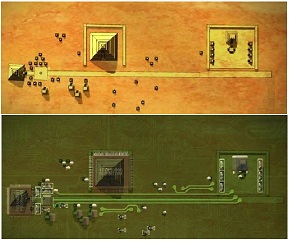
S&F'd.. but why stop there?

genesis 6:4
4The Nephilim were on the earth in those days, and also afterward, when the sons of God came in to the daughters of men, and they bore children to them. Those were the mighty men who were of old, men of renown
new topics
-
Real Time Doom Porn
Predictions & Prophecies: 1 hours ago -
Comparison of Traffic on Four Forum Boards
General Chit Chat: 5 hours ago -
Trump VP question?
US Political Madness: 6 hours ago -
Constitutional AI
Science & Technology: 7 hours ago -
Bio-life as a bootloader for AI to explain the Fermi paradox
Aliens and UFOs: 7 hours ago -
'Paranormal - the Village that saw Aliens' featuring Sian Eleri - a fair report from BBC.?!
Aliens and UFOs: 8 hours ago -
Is The US at War With Yemen?
Middle East Issues: 8 hours ago -
Be humble, be thankful - to a thousand generations - the second commandment, of promise..
Conspiracies in Religions: 11 hours ago
top topics
-
Voting machine contract under scrutiny following discrepancies in Puerto Rico’s primaries
2024 Elections: 16 hours ago, 9 flags -
Globull Warming - Heat wave in UK predicted
Fragile Earth: 16 hours ago, 7 flags -
Massive Iran-Backed Hezb’Allah Strike, Fires Over 215 Rockets At Israel
Middle East Issues: 14 hours ago, 6 flags -
Bio-life as a bootloader for AI to explain the Fermi paradox
Aliens and UFOs: 7 hours ago, 4 flags -
'Paranormal - the Village that saw Aliens' featuring Sian Eleri - a fair report from BBC.?!
Aliens and UFOs: 8 hours ago, 4 flags -
Is The US at War With Yemen?
Middle East Issues: 8 hours ago, 4 flags -
Constitutional AI
Science & Technology: 7 hours ago, 3 flags -
Trump VP question?
US Political Madness: 6 hours ago, 3 flags -
Real Time Doom Porn
Predictions & Prophecies: 1 hours ago, 3 flags -
Be humble, be thankful - to a thousand generations - the second commandment, of promise..
Conspiracies in Religions: 11 hours ago, 1 flags
active topics
-
Is The US at War With Yemen?
Middle East Issues • 19 • : network dude -
Real Time Doom Porn
Predictions & Prophecies • 2 • : chr0naut -
Trump VP question?
US Political Madness • 15 • : Euronymous2625 -
Biden Has Not Connected One Person with High-Speed Internet
US Political Madness • 51 • : 38181 -
BLACK AMERICA is Moving towards TRUMP After Being Used-Abused-Insulted by President BIDEN.
2024 Elections • 36 • : chr0naut -
Constitutional AI
Science & Technology • 1 • : VariedcodeSole -
Voting machine contract under scrutiny following discrepancies in Puerto Rico’s primaries
2024 Elections • 11 • : Dalamax -
Understanding the Biblical story of Abraham's intended sacrifice of Isaac...
Conspiracies in Religions • 13 • : andy06shake -
Bio-life as a bootloader for AI to explain the Fermi paradox
Aliens and UFOs • 2 • : andy06shake -
Nasa astronaut distress message broadcast in error, Maybe!
General Conspiracies • 16 • : Dalamax
